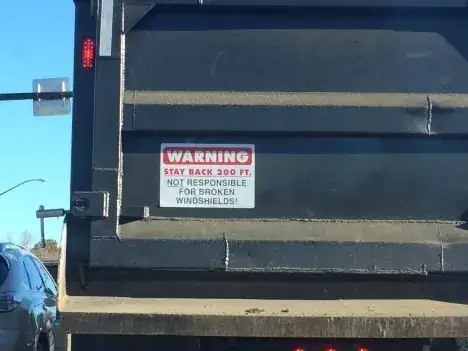Last night, I was driving behind a truck that had a very official-looking sign like this:
(Sign says, "WARNING STAY BACK 200 FT. NOT RESPONSIBLE FOR BROKEN WINDSHIELDS!")
Some cursory Googling brought me to this page from an attorney (who is coincidentally in my home state) who claims:
The simple fact is that we are all responsible for the damage we intentionally or negligently cause to others. If you (1) haul rocks, (2) fail to properly secure those rocks, and (3) one of those rocks breaks my windshield, (4) you are responsible for my broken windshield! Likewise, If I wear a t-shirt that says “Not Responsible For Punching You In The Face” and I walk up and punch you in the face, I am responsible for your broken nose.
With respect to this information, what is the legality of these signs?
They appear to be purchased and installed by the company that owns these trucks, but do restrictions exist preventing corporations from obfuscating their liability in public with false claims that are official in appearance?
It seems like some kind of consumer protection might relate to the insurace/liability aspect; from what I understand, the three elements of fraud are satisfied here:
- intentional deceit, since the company almost certainly knows that this is not true;
- benefit to the deceiver, since the company may avoid paying reasonable damages by misrepresenting their liability;
- actual harm caused, since people with windshields damaged by the company won't follow through with reasonable damage claims when they've been misled by the sign.
As an aside, these signs are far too small to be legible from 200 feet away. If they were legally-binding and drivers within 200 feet were at fault for any damage incurred to their vehicles, would there be a valid reasonableness argument against them (the signs) relating to their 'readability' at the prescribed distance?
